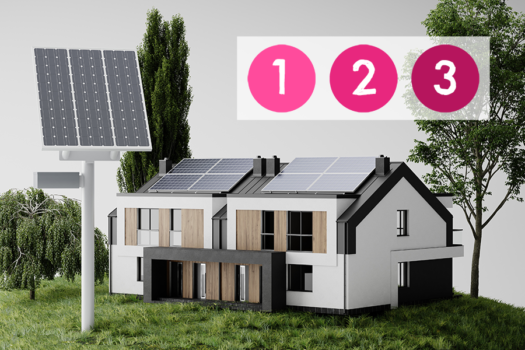All products are selected by our Sharp Survivalist editors. If you buy something through our links as an Amazon Associate we earn from qualifying purchases.

Many people are looking to become more self-reliant, and to create an ‘off the grid’ home with less reliance on public services. However, most assume this would be an intimidating task. In reality, it’s quite achievable and can provide you and your family a greater sense of independence and lower living costs .
By taking the time to develop these 3 areas of your home, you can create a home that is both autonomous and sustainable.
The three key steps to creating a self-reliant home are:
- Investing in a solar energy or wind energy system.
- Installing rainwater collection tanks.
- Growing a sustainable garden.
By investing in an alternative energy source, you can slash your power bills, and have confidence in your supply of electricity regardless of what’s happening to your local grid.
Using rainwater tanks ensure a ready source of all important water.
Having your own sustainable garden means your family will have access to nutritious meals independent of general food prices or availability.
Read on to find out more about these three key sustainable home features…
All products are independently selected by our Sharp Survivalist editors.
If you buy something through our links, we may earn an affiliate commission.
Take Your Power Off the Grid
- Solar Energy
Solar energy is a popular way to create power for a self-reliant home.
Solar panels can be easily sourced and once installed are used to generate electricity, making it possible for a homeowner to become completely off the grid and independent from traditional electric companies.
While solar panels can come a significant price, the benefit of reduced power bills can pay off the cost in just a few years.
Installing solar panels on your rooftop or in an open area nearby is one of the most popular ways to tap into this natural energy resource. Before starting any installation project, it’s important that you understand what type of system works best with your specific needs as well as local regulations and requirements. - Wind Energy
Tapping into wind energy is another way to create a self-reliant home. Like solar, it is a renewable resource and an efficient, cost-effective way to generate electricity.
Well suited to larger properties, wind turbines can be used to power lights, appliances, and electric vehicles within the home. Installing wind turbines can benefit homeowners in many ways – saving money on utility bills and providing an environmentally friendly source of power.
The main advantage of using wind energy is that it does not require any fuel or other expensive resources for operation. This means that once the wind turbine has been installed, there are no additional costs associated with running it. Additionally, modern turbines are designed with safety features in mind so they can operate safely even when high winds occur.
With careful planning and installation techniques, a homeowner can easily reap the benefits of this renewable energy source while minimizing environmental impacts at the same time.
Collect Rainwater
For those looking to create an ‘off the grid’ home, collecting rainwater is probably the most important task. Not only does it help reduce water bills, but it will keep your garden plentiful. By adding a simple filtration system, you can also ensure your family has access to all-important drinking water, which is essential in these (increasing) times of water shortages.
Using rainwater collection tanks has become increasingly popular, even in urban areas, as more and more people seek out ways to cut down on their reliance on public utilities.
Collecting rainwater is surprisingly simple and straightforward – all that’s required is a catchment system such as gutters attached to the roof of your home. From there, you’ll need some type of storage receptacle such as barrels or tanks that will be able to hold the collected water until needed. For full self-reliance you will need room for very large catchment tanks.
Grow a Sustainable Garden
Families looking to create a self-reliant home will benefit in spades from sustainable gardening. By taking advantage of natural resources, gardeners can grow their own food and enjoy the fruits of their labors year-round. Sustainable gardening is an excellent way to reduce reliance on grocery stores, as well as lowering carbon footprints by utilizing renewable energy sources in the garden.
Sustainable gardening starts with creating a plan for your garden that works with your environment. Even smaller properties can do this by using creative gardening ideas like hanging planters and space saving planter pots. When deciding what type of plants, you want to grow, consider how much space you have and which crops are most suitable for your climate. It is also important to choose water-wise plants that require minimal watering and soil amendments such as compost or mulch for nutrient retention.
Increasing Your Homes Self Reliance Is Becoming More Important
As climate change takes effect, and with growing instances of civil unrest, many people find their faith in the future of public services dwindling.
Why it is important to reduce your reliance on public power, water, and food services.
- When you can take charge of your own life and resources, you can become empowered to make decisions that suit your needs, as opposed to having to rely on outside forces.
- Being self-sufficient can provide greater protection from economic downturns or natural disasters, by safeguarding access to basic necessities such as food, water, shelter, and energy.
- It can enable people to save money through efficient use of resources like time and labor.
- Becoming self-reliant helps reduce one’s environmental footprint by decreasing dependence on non-renewable materials or services from large entities with potentially damaging environmental consequences.
Creating a self-reliant home has numerous benefits ranging from financial savings and increased safety, to improved confidence and greater freedom.
Start thinking about how to generate your own energy sources such as solar or wind power. You should also consider items such as water collection and filtration systems so that you can rely on your own supply of clean drinking water. Develop a garden and start growing your own food to become self-reliant.
You can do it!
Looking for somewhere to start in your journey to becoming a sharp survivalist?
Check out our recommended items!

